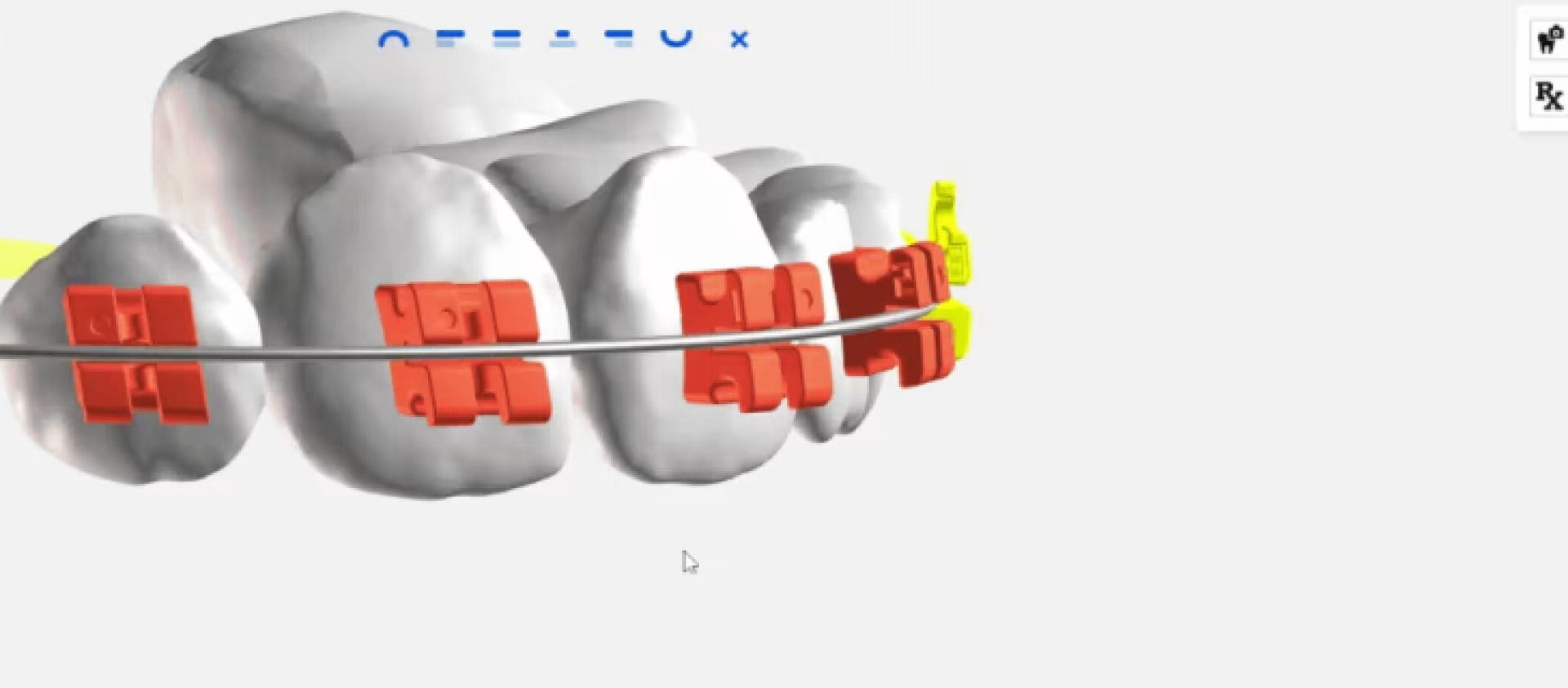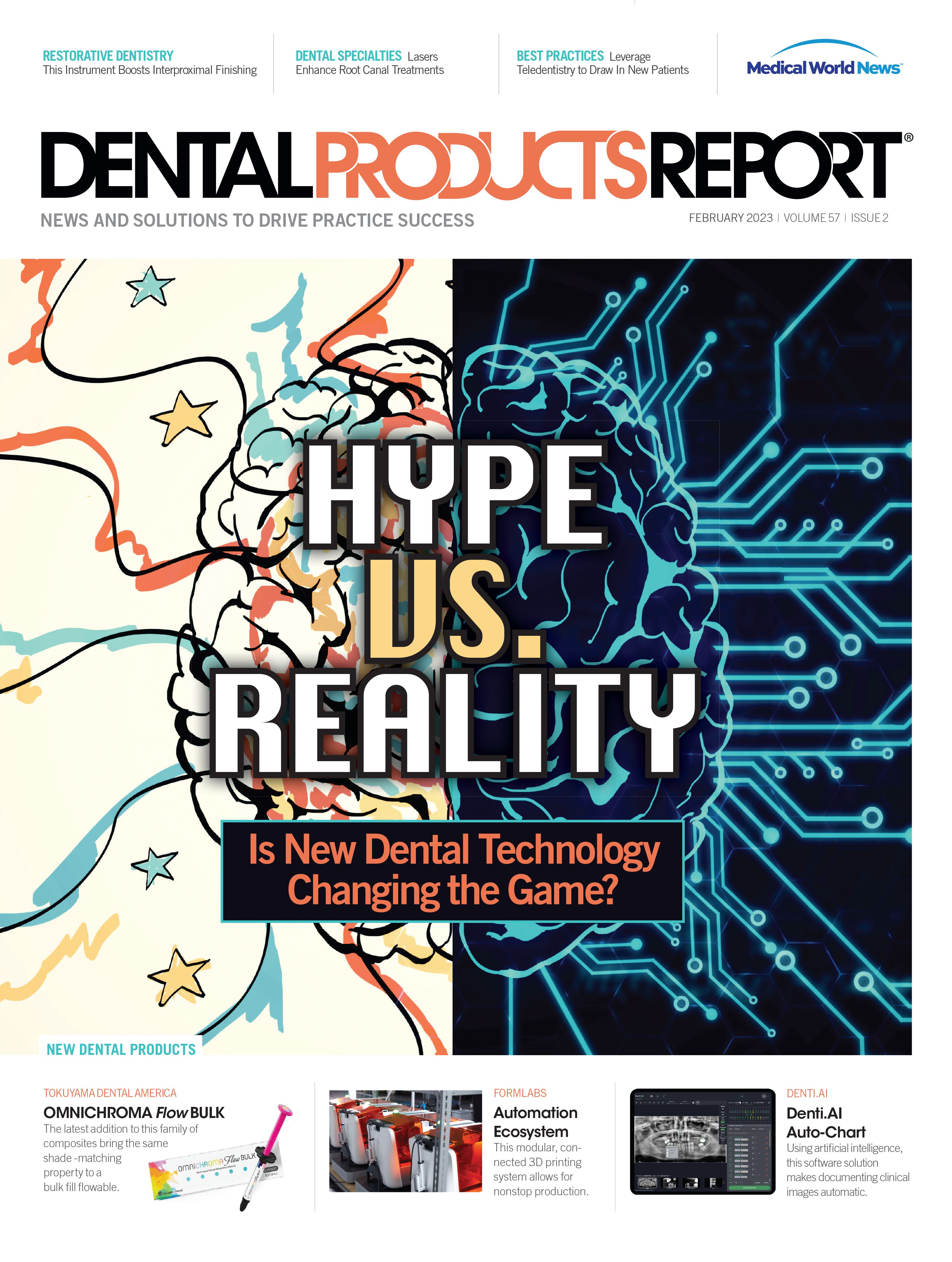Customized Brackets for Patients With Braces
3D printing and CAD technology have enabled LightForce to customize brackets in the same way that clear aligners are printed to fit each patient.
LightForce uses 3D-printed ceramic polycrystalline alumina brackets that are completely customizable to suit individual needs. The brackets are available in a variety of slot sizes as well as bidimensional configurations.

As the son of an orthodontist, Alfred Griffin, DMD, PhD, co-founder and CEO of LightForce, has a deep understanding of both the dental industry and the field of orthodontics. And even as an orthodontic resident, he wanted to bring positive change to his chosen specialty. He didn’t want to reinvent the wheel, but he believed that the wheel wasn’t rolling as efficiently as it could and needed some improvements—specifically, advances in digital workflow and 3D printing.
At Dr Griffin’s practice, only about 20% of patients were getting clear aligners, and he was frustrated that there wasn’t a digital workflow for the 70% to 80% of cases that needed traditional braces. He found that those patients could not be treated as accurately as clear-aligner patients because information about braces was obtainable only visually. It became obvious to him that better technology was needed for braces. Because he needed the type of data that was easily provided by the software that came with customizable clear aligners, he began uploading every braces case to his clear-aligner software to map all the details, from jaw angles to occlusal contacts to whether there was a need for interproximal reduction.
“Clear-aligner software was the first window into what a fully digital workflow could look like in orthodontics, but we were missing the largest segment of the market, which is braces,” Dr Griffin says. “There’s a lot of data that goes into every orthodontic patient that is impossible to learn just by line of sight, a mirror, and loupes. A digital process adds tremendous value, not just to the practice workflow and efficiency, but also to outcomes for the patient.”
Dr Griffin’s practice is located in Boston, Massachusetts, largely considered the global epicenter for 3D printing and CAD software—both essential for the scaling of mass customized orthodontic appliances—and it was that software that addressed the main challenges to digital growth.
“We’ve just always been limited by the technology of the day,” Dr Griffin explains. “I like to think if the people who originally invented the straight-wire appliance 40 years ago had access to similar technology, they would have done the same thing. The challenge has always been the execution.”
Thanks to advances like 3D printing and cloud-based CAD technology, however, it was possible to customize braces for patients, Dr Griffin points out. Essentially, orthodontists would be able to print customized brackets in the same way that clear aligners are printed to fit each patient, rather than having the one-size-fits-all brackets that were previously being employed.
The idea was there, and the manufacturing technology was ready and waiting. Dr Griffin’s next step was to figure out how to turn his idea into a reality.
“I certainly did not have a lot of business training in dental school,” he says, laughing. “I knew it was a good idea, but I needed to find someone who had the expertise to implement it.”
He found it in Lou Shuman, DMD, CAGS, an orthodontist and founder/CEO of Cellerant Consulting. Dr Shuman had a reputation for knowing a good idea when he heard one.
“It didn’t take Lou 2 seconds to say, ‘This is a great idea; we need to build a company,’” Dr Griffin recalls. “We talked about how we wanted to be the company that doctors trust and recommend to their friends because orthodontics is a community we care about. I knew from there [that] I had the right partner. And then, we were chosen as Gold Winner at the 2016 annual MassChallenge Boston Awards, which really gave us some external validation that enabled us to take the next step.”
To launch the company, they needed more hands on deck. In a unique move, they formed an executive team made up of experienced professionals from a variety of fields, including manufacturing, technology, robotics, and consumer product development.
Dr Shuman remember the enormous impact Dr Griffin’s vision had on their company’s growth. “Alfred reached outside of dentistry and brought a level of expertise into the company like never seen before,” Dr Shuman says. “He came up with a concept that truly took orthodontics into the digital realm. No one else had ever been able to create 100% custom 3D-printed brackets.”
Why LightForce Matters
Before LightForce, orthodontics had lagged behind in terms of customization. Although clear aligners provided a certain level of personalized treatment, brackets still came in only 1 size, and it was up to the orthodontist to place and fine-tune them for each patient. Each stock bracket requires adjustment, repositioning, and wire bending, which can be time-consuming and takes up chair time. With LightForce’s 3D printing, customization is accomplished before brackets go into the mouth.
That way, the number of adjustments is reduced and so are the number of appointments. “If we can start with the ideal shape of that bracket and the ideal position, we don’t have to bend wires or reposition brackets, so we eliminate all those appointments for each case,” Dr Griffin says. “That means every tooth in the mouth takes essentially a direct flight to their ideal position as prescribed by the doctor, versus an indirect flight, which requires more tooth movement than is needed. Essentially, you’re starting with the end in mind.”
Before LightForce, “orthodontists just had one kind of bracket, where the base of the bracket doesn’t fit the tooth,” Dr Shuman says, but “with LightForce, the base of the bracket is literally customized to fit each tooth’s anatomy exactly. It really is a game changer.”
The digital nature of the process also allows for faster treatment. A mold can be modified just by changing an STL 3D-printing file, leading to many benefits, including decreasing turnaround time, accelerated tooth movement, and reduced chair and treatment time.
“With LightForce, you don’t need to monitor as closely,” Dr Shuman says. “You let the treatment plan work itself out. With stock brackets, you need to see that patient every 4 to 6 weeks because you’re not really sure what’s happening; you put the braces on by line of sight, but now you’ve got to react to it. You’re reactive. You can be proactive with LightForce. And so instead of every 4 to 6 weeks, you can see the patient every 8 to 10 weeks.”
Shorter treatment times are more convenient for patients and reduce patient burnout. If a patient has to be seen only 10 times instead of 17, that’s much less time that a parent needs to take off from work or that a child needs to miss school—a plus for everyone involved.
“The modern consumer values efficiency more than ever before,” Dr Griffin says. “Our early data suggests that we save roughly 8 months of treatment time, around 40% fewer months in treatment and 40% fewer visits. That’s substantial. And it’s because you’re starting with the ideal end results in mind.”
Implications for Dentistry
Many of the negative outcomes for patients with braces are closely correlated to treatment duration. The longer the treatment, the higher the risk of white spot lesions, cavities around brackets, and recession. Several studies have found that the risk of root resorption (which can lead to the tooth’s support being compromised, potentially to the point of tooth loss) increases with the length of treatment.1
“If we can reduce those issues, then we’re going to get better outcomes,” Griffin states. “More and more people are getting braces than ever before; it’s growing at a 15% compounded annual growth rate. This means we need to continue to provide a higher standard of care for every patient.”
“The benefit is so much more far-reaching than just the technology shift,” Dr Shuman adds. “LightForce technology has a tremendous impact on how we treat patients and their treatment outcomes.”
Dr Shuman also notes that shorter treatment time means patients will return to the general practitioner’s (GP) office more quickly. “That has always been an issue,” he says. “After the GP refers to the orthodontist, the GP is left wondering when they will see that patient again. So, by the efficiency of the LightForce technology, we’re able to get that patient back to the GP quicker.”
A positive experience with the orthodontist also reflects well on the referring dentist. If the patients have an ideal and timely outcome, they will appreciate that the dentist referred them to that technology-savvy orthodontist.
“Contemporary dental professionals now are thinking [about] what the modern patient wants out of their experience,” Dr Griffin says. “People are redesigning offices and workflows around the modern consumer, and we’re thinking about that as well. I want to start my patients off in a place where I know their treatment is going to be successful.”
What the Future Holds
Although LightForce technology has only been available for 2 years, already more than 8% of North American orthodontists are using it—and with good results.
“We are quantifying the outcomes now,” Dr Griffin says. “What we’re seeing qualitatively is that doctors are reporting better outcomes with LightForce, and we expect quantitative data shortly.”
The impact of this technology has already become apparent to the industry, and the American Association of Orthodontics (AAO) chose Dr Griffin as the 2022 Ortho Innovator of the Year.
“The AAO is looking to the future and recognizing that LightForce is really moving the needle for the whole profession,” Dr Shuman points out. “LightForce is pushing technology to a level that will have implications far outside just orthodontics.”
Dr Griffin believes this forward-thinking industry is excited about the future. According to him, it is dentistry that is advancing the 3D-printing industry, largely due to its being the biggest user of 3D-printing technology. In fact, the largest 3D-printing company today is Align Technologies.
“We are pushing technology forward,” he says. “3D printing in dentistry shows that we value customization more than any other field of medicine or industry. I think in the future, everything that goes into the mouth should be customized because there’s a clinical benefit to both the doctor and the patient. And 3D printing and digital innovation are enabling this.”
Reference
- Krishnan V. Critical issues concerning root resorption: a contemporary review. World J. Orthod. 2005;6(1):30-40.

ACTIVA BioACTIVE Bulk Flow Marks Pulpdent’s First Major Product Release in 4 Years
December 12th 2024Next-generation bulk-fill dental restorative raises the standard of care for bulk-fill procedures by providing natural remineralization support, while also overcoming current bulk-fill limitations.